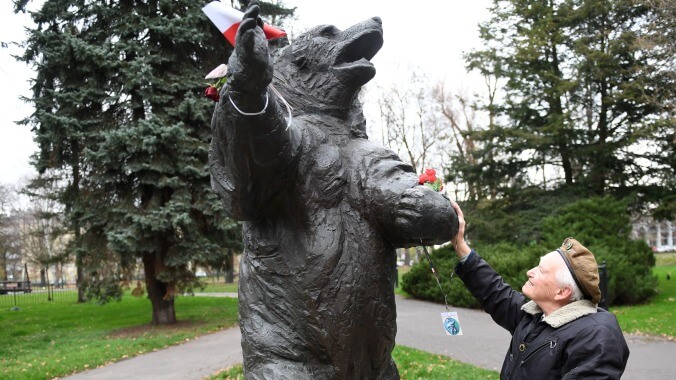During WWII, a bear joined the Polish army

This week’s entry: Wojtek
What it’s about: There’s no rule on the books that says a mule can’t kick a field goal, and apparently there’s no rule against a bear joining the Polish army. Wojtek was a bear cub that was rescued by and mustered into the Polish army during WWII. It rose to the rank of corporal, teaching his unit invaluable lessons on assaulting pic-a-nic baskets.
Biggest controversy: Enlisting a bear was surprisingly uncontroversial. The Polish II Corps took on the bear cub as a mascot, naming him Wojtek (a nickname for Wojciech, a Polish name that means “happy warrior”). As a cub, he was fed condensed milk from an old vodka bottle; as he grew he ate fruit, marmalade, and honey. He also enjoyed drinking coffee and beer and eating cigarettes. When the unit was assigned to fight in Italy, the British transport that ferried them across the Mediterranean didn’t allow mascots or pets, so to skirt regulations, Wojtek was drafted into the army as a private and assigned to the 22nd Artillery Supply Company.
Strangest fact: Wojtek never set a paw in Poland. The II Corps were refugees, fleeing the Soviet takeover of their country. They were in Iran, escorting thousands of civilians who fled rather than be deported to the USSR when they found the Syrian brown bear cub, orphaned by hunters. The unit marched through Iraq, Syria, Palestine, and Egypt, before participating in the Allied invasion of Italy, but that’s as far north as they went. After the war, Wotjek’s company was stationed in Berwickshire, Scotland, and after his discharge from the army, the bear moved to Edinburgh Zoo, where he occasionally made appearances on the BBC children’s show Blue Peter.
Thing we were happiest to learn: Wojtek was a good soldier. After spending enough time around humans, the bear began imitating his human brothers-in-arms, marching on hind legs and saluting. He’d also playfully wrestle with soldiers, and bunk with other soldiers to keep them warm at night. During the Battle of Monte Cassino, Wojtek carried crates of artillery shells. The bear was promoted to corporal for his efforts, and the 22nd Artillery adopted a new emblem: a bear carrying a massive shell case.
Thing we were unhappiest to learn: There aren’t more enlisted animals out there. While there is a list of of military animals of WWII, they’re largely service dogs who were awarded medals; the only one to actually enlist was Just Nuisance, a dog enlisted in the Royal Navy to protect him from being put down. (We’re also unhappy to learn, if unsurprised, that a Royal Air Force mascot dog on the list has a racial slur as its name. As illustrated in our Wikipedia Wormhole from a few weeks ago, racism was alive and well on both sides of the lines in WWII.)
Best link to elsewhere on Wikipedia: Wojtek was rescued by the group of Polish refugees largely through the efforts of teenager Irena Bokiewicz, who convinced a lieutenant in the Polish II Corps to buy the bear (from whom isn’t clear), and was the bear’s principal caregiver until he joined the army. Irena’s great uncle was General Bolesław Wieniawa-Długoszowski, an artist, poet, physician, decorated WWI veteran, ambassador, and president of Poland for only one day. In September of 1939, President Ignacy Mościcki retired, appointing Wieniawa-Długoszowski as a caretaker president until elections could be held. The Soviet Army invaded the same day, and Wieniawa-Długoszowski fled to Paris and then New York.
Further down the Wormhole: As we mentioned, Wojtek is a nickname for Wojciech, but some enterprising Wikipedia editor got out their thesaurus and observed that the name is also a diminutive and a hypocorism. The latter is a fancy word for a pet name (literally and figuratively, in this case). Unsurprisingly, Wikipedia has a list of types of pseudonyms, including Bugō (a nickname used in Japanese martial arts, literally “warrior name”), stage names, and pen names. One of the most accomplished and mysterious pen names is that of B. Traven, whose works include The Treasure Of The Sierra Madre, and about whom almost nothing is known. We’ll delve into the real-life mystery behind Traven’s fiction next week.